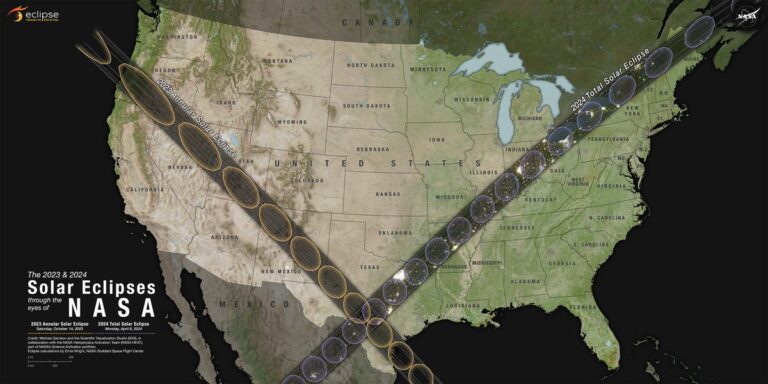A “ring of fire” solar eclipse is occurring over the western United States, from Oregon to Texas, on October 14.
kdshutterman / Getty Images
If you’re in the eastern half of the country, don’t fret. You’ll be treated to a total solar eclipse in April 2024.
NASA/Connie Moore
NASA released a detailed map showing the paths of those two eclipses. Let’s walk through the best US locations for watching them.
NASA’s Scientific Visualization Studio
We’ll start with October 14, 2023, when the moon will pass in front of the sun while it’s at its farthest point from Earth.
Reuters
Since the moon appears smaller, it won’t completely cover the sun. It will leave a “ring of fire” around its shadow. This is called an annular solar eclipse.
JAXA/NASA/Hinode via Getty Images
From Portland, Seattle, or the San Francisco Bay Area, your closest option is Eugene or Klamath Falls in Oregon. Inside the oval, the eclipse occurs at the noted time.
NASA’s Scientific Visualization Studio
The lines on the NASA map indicate how long the eclipse will last. The outermost lines along the path show where the eclipse will last a minute or two. On the innermost lines it will last 4 1/2 minutes.
NASA’s Scientific Visualization Studio
Purple and yellow lines cutting across the map also show where you can see a partial eclipse outside the paths of the moon’s full shadow.
Download a high-resolution version of the map to follow those lines on NASA’s website.
If you want a desert eclipse experience, the “path of annularity” passes right through northeastern Nevada and southern Utah.
NASA’s Scientific Visualization Studio
In Santa Fe or Albuquerque? You’re in luck! The eclipse will pass right over you, as well as the UFO-famous Roswell, New Mexico.
NASA’s Scientific Visualization Studio
San Antonio might be the luckiest city of all. The annular eclipse will last four minutes there. The following year, residents can drive just to the northwest to see the total eclipse.
NASA’s Scientific Visualization Studio
In that total solar eclipse, on April 8, 2024, the moon will be close enough to Earth to completely block out the sun in a brief moment of “totality.”
Miloslav Druckmüller/NASA
That eclipse will be visible only to a large swath of the US and parts of Mexico and Canada.
NASA/Scientific Visualization Studio/Michala Garrison; eclipse calculations by Ernie Wright, NASA Goddard Space Flight Center
It will be the last total solar eclipse to be visible from the contiguous US until 2044. The eclipse will begin near San Antonio and then move to Austin and Dallas.
NASA’s Scientific Visualization Studio
Then the eclipse will cast its shadow over Arkansas and southeastern Missouri.
NASA’s Scientific Visualization Studio
The rest of the Midwest can flock to southern Illinois, Indianapolis, or Cleveland to get into the path of totality.
NASA’s Scientific Visualization Studio
Much of the northeast can get its eclipse fix by driving to upstate New York.
NASA’s Scientific Visualization Studio
Everyone’s last chance to see a total solar eclipse in the US for another 20 years will be late afternoon in northern Vermont, New Hampshire, and Maine.
NASA’s Scientific Visualization Studio
No matter where you are or which eclipse you’re watching, don’t forget to protect your eyes. Happy viewing!
Getty Images
Correction: April 5, 2023 — An earlier version of this story misstated where people would be able to see both the annular eclipse and the total eclipse. It’s San Antonio, Texas, not San Antonio, New Mexico.
This story has been updated. It was originally published on April 5, 2023.


